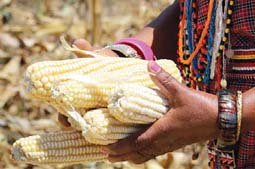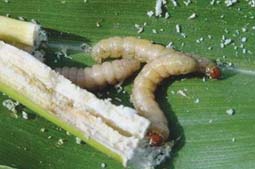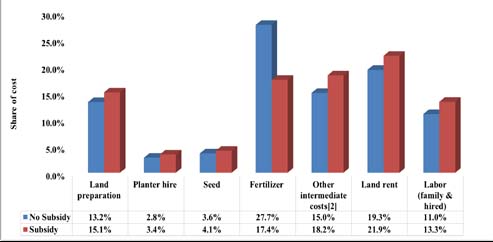Maize Granaries of Kenya
 Farmers tend to market their maize crop immediately after harvest in order to meet their financial obligations and to prepare for the next season. Due to this practice, maize supply becomes artificially higher than the demand thereby forcing prices to drop; only to increase within four months after selling to discuss this cereals magazine interviewed several growers in Trans Nzoia County.
Farmers tend to market their maize crop immediately after harvest in order to meet their financial obligations and to prepare for the next season. Due to this practice, maize supply becomes artificially higher than the demand thereby forcing prices to drop; only to increase within four months after selling to discuss this cereals magazine interviewed several growers in Trans Nzoia County.
Briefly discuss Maize growing in Trans Nzoia County and the country as a whole?
Maize farming in Trans Nzoia has been the main activity since colonial times and has always been described as the maize granaries of Kenya. The difference between now and then is that the big farms that used to produce bulk of maize are no longer there as most have been sold and sub divided in to small plots that can only produce subsistence crop for families and little as commercial crop. Big parastatals like ADC and Kenya Seed have set foot in Trans Nzoia as commercial producers of maize seed and maize farming but were run down and most of their farms subdivided to individuals as settlement schemes.
These actions have created shortages of supply to the buyer, the National Cereals Produce Board of Kenya. Trans Nzoia enjoys suitable climate, soils and rainfall patterns that enable maize to do well and produce optimally. In the country as whole maize growing is practiced everywhere as it provides the stable meals of most Kenyans but nowhere else it is done in the scale of Trans Nzoia. The weather patterns favour other crops like wheat, coffee and tea but maize growing is the most practiced.
 What challenges are maize farmers facing currently? What do you think would be the tentative solutions?
What challenges are maize farmers facing currently? What do you think would be the tentative solutions?
Trans Nzoia has no big lands, costs of implements and inputs are high due to rising cost of fuel, and dollar rates. The main challenges are inputs especially availability of good seeds specific to the altitude and prevailing weather pattern as it varies from different altitudes and locations within Trans Nzoia county. Some of the recently introduced high yielding seeds have come with challenges such as diseases, easily attacked by Borers as grains, and rots while still on stalk on the cob. Other challenges are easy availability of subsidence fertilizer from the Ministry of Agriculture through the NCPB, which for long has been riddled with corruption and adulteration of the fertilizer.
Egerton University Cost of Maize Production – Aggregate for Areas Visited
| Large Scale | Small Scale | |
|
Maize yield (bags/acre) |
26 2,333 60,667 |
17.4 |
|
Land preparation |
5,500 1,167 1,500 11,499 6,210 8,000 4,564 3,075 41,515 |
3,960 1,175 1,500 5,560 2,086 7,500 5,842 2,210 29,833 |
| Cost per bag with LR &WC Breakeven yield (90kg bags) Profit per bag (Ksh) with LR & WC Profit per bag with LR &WC (%) |
1,597 18 737 46% |
1,715 10.4 215 13% |
| Cost per bag without LR & WC Profit per bag (Ksh) w/o LR & WC Profit per bag w/o LR & WC (%) |
1,171 1,162 99% |
1,156 774 67% |
Farmers are therefore forced to seek alternative sources that are traders who rip them off as they sell at exorbitant prices and quality not assured. Farmers also have nowhere to sell their produce but to the middlemen who exploit them and buy at cheap price and sell to millers at higher prices. Farmers face bad roads to their farms and transportation of input and harvests are hindered logistically creating possible crop failure due to delayed planting and grain degradation through borers or rotting.

Solutions
1. National Government Level
The distribution of inputs should be managed to benefit farmers through easy accessibility at sub county levels rather than the main NCPB stores. The government should subsidise both seeds and fertilizers to cushion farmers from high cost of production. Regulate price of diesel and oils that are directly used for maize growing (ploughing, Planting and harvesting). Create regulation that removes the middlemen from dealing with maize and avail capital to purchase maize directly from farmers.
2. County Government Level
The logistics to farmers land should be improved and ensure extension officers are working through educating farmers on best farming practices and which seeds suit their areas. Ensure local traders sale genuine fertilizers and at recommended prices as they regulate the trading licences. Assist the research centres (KALRO) to carry out trials on various imported seeds before releasing to the farmers to avoid diseases and inferior quality maize which can cause loses. Purchase farmers produce directly at recommended price and store for sell to the millers or other distributors. This will cut out the middlemen who exploit farmers. Regulate exit of produce from Trans Nzoia to other counties without paying cess to the county. Also ensure cheap imports from neighbouring countries do not find their way into the county affecting the prices for the local farmers. Assist farmers through extension officers with weather patterns and forecast in order to plant in time and harvest before rains.
3. Investor level
For maximum yield and income, the farmer must ensure they maximise on the good practices and avoid cost cutting. Maximum recommended fertilizer, certified seeds, good land preparations and timely agricultural practices. (Land preparation, planting, weeding, top dressing, and Harvesting). Farmers should also ensure the storage of the produce is suitable and dried to the recommended moisture level and coated with insecticide to prevent borers from destroying the grain. This will enable them hold on to their maize until prices are suitable to dispose of their produce. Avoid selling to the middlemen and form cooperatives which can be their vehicle to bargaining.
 What would you advice maize farmers to ensure they earn maximum profits?
What would you advice maize farmers to ensure they earn maximum profits?
Farmers must follow the recommended farm practices without diverting to cost saving in all cultural practices. They must abide by the recommendations given by the experts as this is the only way to maximise production. From land preparation, certified seeds fertilizers, top dressing and weeding should be done in timely and proper way. Avoid phone farming where the farmer is far away and only give instruction to workers.
Avoid selling maize to the middlemen and store their maize until prices are acceptable. Seek opinions and advice from old farmers who have experience and expertise in maize farming as they posses’ wealth of knowledge on weather patterns for proper timing and proper seeds and fertilizers. Avoid buying inputs from unrecommended dealers as fake products can cause losses.
Small scale farmers can form cooperatives or unions to advocate for the prices of inputs, produce prices, and government subsidies. Farmers can join farms to make substantial acreage for better per capita yield.
Currently, the country is facing a serious famine, Maize being the staple food in the country, Do you think the country is not producing enough?
The country has the potential to produce enough but the challenges facing farmers impedes the maximum production from being achieved. Most farmers have leased out their farms to brief case farmers who have no idea what to do to get better yields. Big plantation farms have been subdivided into smaller farms that cannot produce for commercial sales. For sure the country is not producing enough to satisfy demand but it is because the potential has not been fully implemented. If the vast lands like wheat in Narok would be exploited for maize production then surplus would be realised. Hoarding by millers who have several silos in different counties also creates shortages which can be a way of making profit through value added products like shifted maize meal. Non-governmental organisations distributing food to the famine areas would rather import from other countries than buy from farmers. For example we see bags of maize with WHO, USAID, people of china etc, yet the farmer has nowhere to sell their maize. I would say this shortage is created to induce importation of maize.
What should be done to prevent these cycles of famine?
The government should support farmers but above all have food reserves as it was in the past where NCPB was the custodian of all grains reserve and distribution was only from this organisation. The government would therefore have food security at their fingertips and control distribution and imports. Due to poor produce management it has result in farmers abandoning the growing of maize by planting alternative crops like sugarcane where the returns are more attractive and guaranteed. Bottom line is to assure farmers of good return to their effort and food security will be guaranteed. Prevent cheap imports that make farmers loose market for their produce.
Irrigation has been prescribed as the way forward, do you agree?
It can only be possible if the cost of investment can be paid off with money generated from the maize. At the present rate the cost of running irrigation will not be feasible. Already with rain fed growing it is hard for farmers to break even, then it will be harder with irrigation cost. When this has been tried in Galana it was concluded production has to be 40 to 50 bags per acre to make financial sense. The only effective irrigation is centre pivot system which is quite costly to install and to run. Secondly it needs a vast piece of gentle sloping land to run properly. It might be good if this was introduced in drier parts of the country where there is no production to supplement the general country production. For Trans Nzoia I think rain fed still is a better option with the present price scenario.
Kindly tabulate the cost of inputs per acre.
It is variable. The cost will depend on the size of the field, production per acre and ensuring good agricultural practices are well adhered to. The bigger the size of the field, and production per acre, the less the cost of production.
Approximately how much does it cost to produce 1Kg of Maize?
In view of the above, it is approximately 12/- per kg if you add land lease, Plus 10% contingency cost at 30 bags per acre yield.
Any other comments
The cost shown is based on estimates and can be higher depending on the prevailing market cost of inputs especially fuel which will determine transport and fertilizer cost. The land issue is sensitive and reserving land like ADC to produce for the national food reserve would help with food security especially during famine. Most of our dry counties with all year round rivers should be developed into irrigation schemes.
Egerton University Share of cost components -Large Scale Production system 